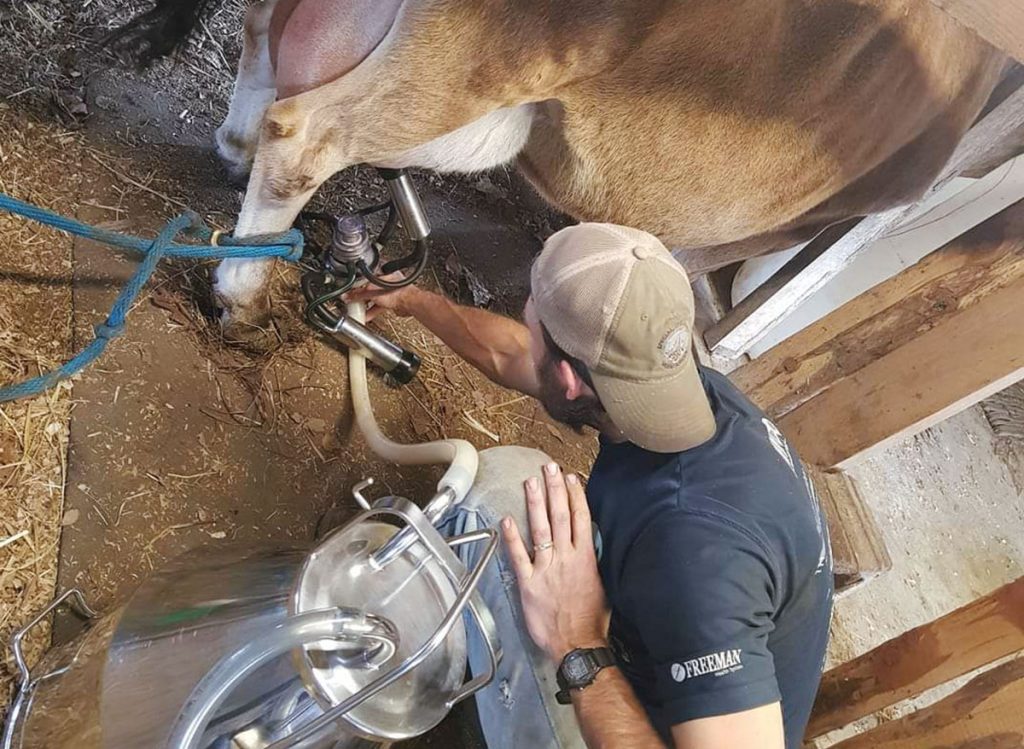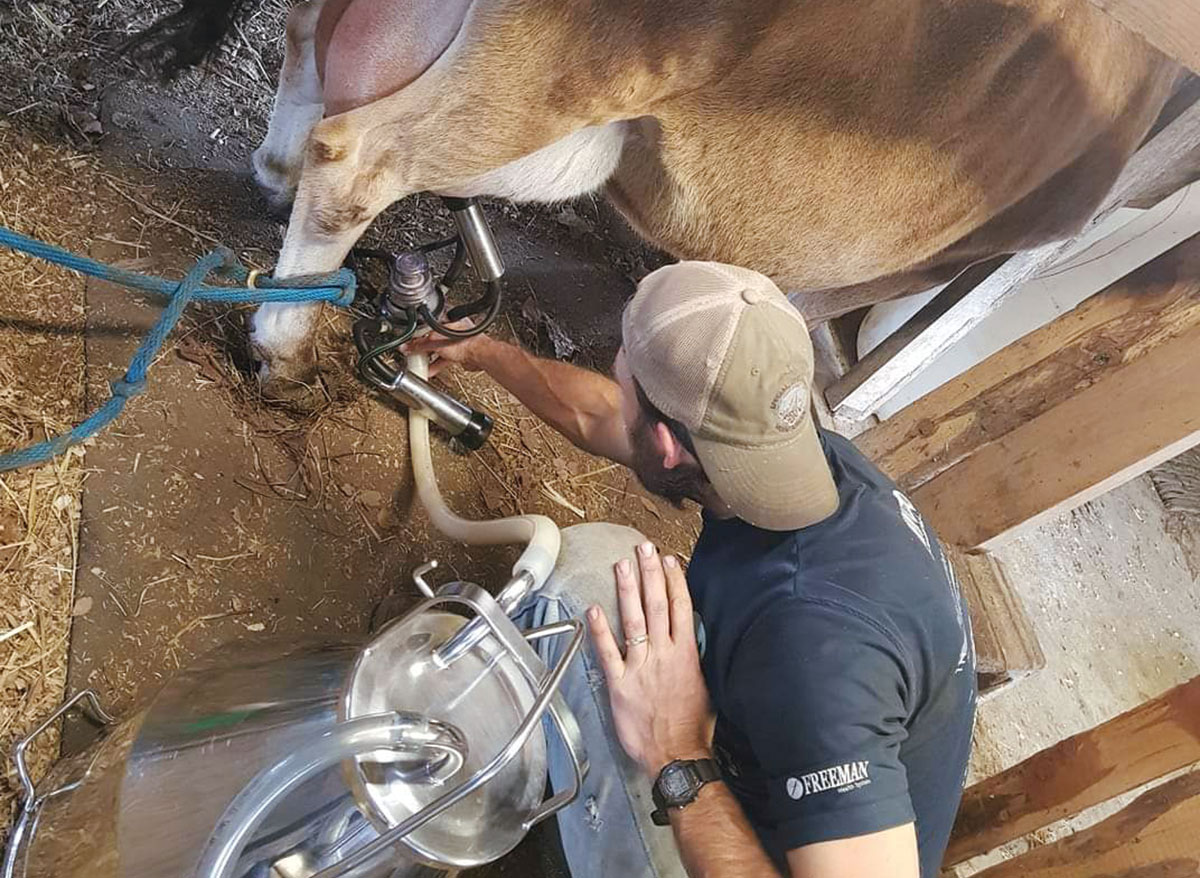
Clint and Joy Ballard own Milk and Honey Hill Farm on 40 acres in the community of New Blaine, Ark. They run a small-scale, diverse family farm producing raw cow milk, honey, eggs, pork, firewood and more.
Clint grew up on a cow/calf operation. As a youngster, his job was to milk their single Guernsey cow while his brothers worked with beef cattle.
Joy was raised in town until she was 5. Then she and her entire family went to Papua New Guinea where her parents served as missionaries. The family returned to the United States when she was 13.
The couple purchased land in 2016 and began milking in 2017. An important consideration in everything they do is Clint serving as a Special Forces medic in the Army National Guard. After having served on active duty for 10 years, Clint joined the National Guard and will soon be retiring after 21 years. During that time, Clint was deployed to eight different countries while Joy and their five children – Aidan (15), Lily (13), Grace (10), Gabriel (8) and Serenity (5) – maintained the farm during his sporadic absences.
Everything changed last year when Clint was deployed for six months to Africa. The six-month deployment required major adjustments, especially in terms of the children’s education and the dairy. Rather than being homeschooled, the children attended two different schools, which required Joy driving three hours per day. Further, Clint didn’t want the family to continue milking in addition to all the other chores involved with the family’s dual mission of promoting income security through diversity and creating better food security for themselves and their customers. The result was suspending the raw milk part of their income.
Bottle calves were purchased, with one highly-productive cow needing to nurse four calves in order to accommodate her milk production.
Clint is now moving the dairy herd toward A2/A2 genetics using AI and a Jersey clean-up bull. Recently the first heifer born and raised on the farm had her first calf. When the calf was born.
The couple selected Jersey rather than the Guernsey from Clint’s childhood as their milking breed. Of course, a prime consideration for a raw milk dairy is the higher fat content, which is up to 6.8 percent for Jerseys as opposed to 5 percent with Guernseys, and a little less than 4 percent with Holsteins.
“I felt Jerseys made more sense for us because they have a smaller frame and are more docile; in addition to being good grazers in Arkansas’s hotter climate,” Clint said.
An equally important consideration centers around milk protein gene markers. The huge majority of milking cattle have a mixture of A1/A2 genes with only a small percentage having A2/A2 genes. Research suggests A2/A2 milk may be easier to digest, perhaps most important for those who are lactose intolerant.
In Arkansas, farms such as the Ballard’s, can sell up to 500 gallons of raw milk off the farm and they usually produce about 300 gallons with any extra going to make personal use yogurt and butter. Most dairy customers drink and cook with the milk and are within 30 miles. Nearby Subiaco is home to Subiaco Academy (a boarding school). Parents, who come from as far away as Louisiana, Texas, Fort Smith or Little Rock, will occasionally buy several gallons at a time when visiting their children.
Other dairy customers are artisan cheesemakers. While at this point Milk and Honey Hill Farm has no production contracts, the cheesemaking market is important. Customers include Hispanic families who often make queso fresco, an unaged, semisoft cheese with a mild, slightly salty flavor and a moist and creamy texture that complements Mexican and other Latin American cuisines. Joy has taught butter and cheesemaking in the past, and looks forward to doing so when family life returns to normal with Clint’s return.
The Ballard’s currently have five Jersey cows and retain heifers so they can expand their milk production. Because Clint prefers calving to coincide with green up, two-thirds are born in the spring and one-third in the fall. Larger spring calving lowers annual feed costs with a 10 percent protein five-way blend from their local co-op used during milking. Extra bottle calves are fed out for personal meat consumption and sold to cover winter hay expenses.
The NRCS has helped ease the burden of start-up capital for key infrastructure on the farm such as water lines, stock waterer, tree thinning and electric fencing. The farm uses rotational grazing organized around a centrally located frost-free waterer with paddocks radiating out and defined by high tensile electric fencing. Silvo-pasture is the blending of forestry and grazing. Tree density is managed to provide sufficient sunlight to reach the pasture. In turn the grazing animals prune and deposit fertilizer for the trees which will produce high quality Pine and hardwood saw logs in 15 years as well as firewood and mulch from the cull trees.
Pastures have been improved through added clover to increase protein content and are comprised mainly of Bermuda with some warm season native grasses. The land is seeded with annual rye grass for winter forage.
A second part of the Ballard operation is three dozen chickens with guinea hens serving as an early warning system for predatory eagles. While the family consumes some of the daily three dozen eggs, they also sell eggs to neighbors and milk customers.
“The folks who come to buy milk, are often very appreciative of being able to buy their eggs, honey and other things here as well,” Clint explained. “The eggs are just another part of our effort to provide food security by having another option besides the grocery store.”
Echoing the diversity of subsistence farms of the past, the Ballards raise pork. They have two Boston Mountain sows that produce two litters a year and run with the boar on 2 wooded acres. Diet is supplemented with waste milk and the same co-op ration in order to keep them accustomed to human handling. An average litter is 10 piglets, half of which are sold at weaning to those who want to raise their own pork. The other half is grown out for slaughter by customers or sold piece-meal after USDA-certified processing.
Six or seven years ago Clint started a honey operation with two hives. He now has 14, most of which came from splitting the hives in the spring though he did capture a few swarms.
“We are happy with the size of our farm and are simply looking to be more efficient and productive, perhaps adding a commercial kitchen as part of our community food security mission,” explained Clint.
Then Joy added, “This is truly a family operation where our children enjoy a good day’s work and learn something that cannot be taught by videogames. Aiden, our oldest, may play computer games for perhaps an hour a day when the workload allows, but he is constantly saying how much he misses working with his dad and the conversations they have together.”







